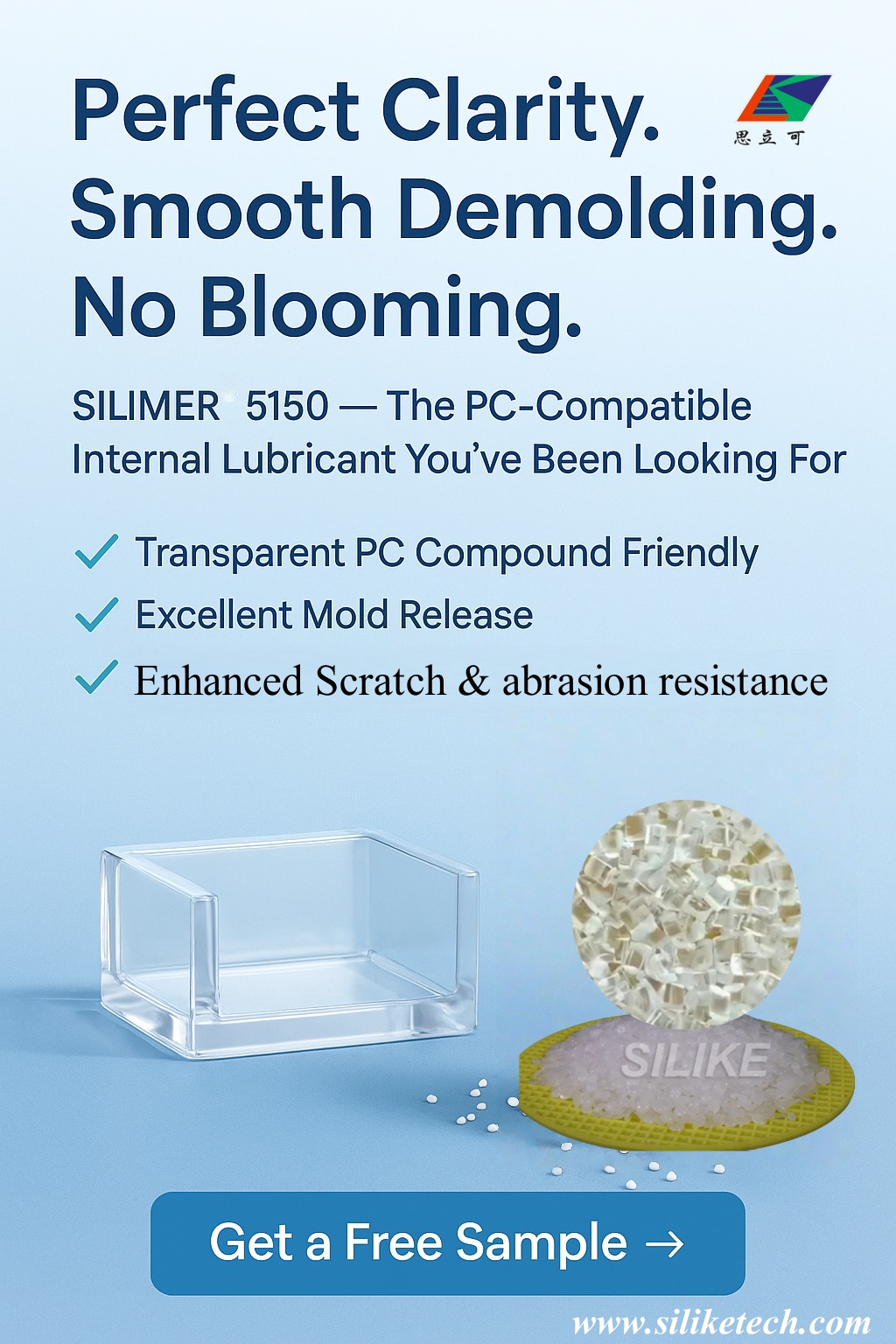Transparent polycarbonate (PC) is widely used in high-end applications such as optical lenses, light covers, medical devices, and consumer electronics due to its excellent transparency, toughness, and heat resistance. However, processing transparent PC poses significant challenges, particularly in achieving smooth mold release and consistent internal lubrication.
What Makes Transparent PC So Popular—And So Challenging to Process?
Transparent PC offers exceptional optical clarity and impact strength, making it ideal for parts requiring aesthetics and performance. But its high melt viscosity and poor flowability often lead to incomplete mold filling, surface defects, and difficulty in demolding. Moreover, any additive used must maintain optical purity, making formulation development highly restrictive.
Why is Demolding and Lubrication a Major Concern in Transparent PC Manufacturing?
Due to its high melt strength and sensitivity to shear, transparent PC can stick to molds during injection or extrusion, causing surface stress, defects, and longer cycle times. Common lubricants or mold release agents often compromise transparency or bloom on the surface, leading to poor aesthetics and downstream issues like coating adhesion failures. Processors need a solution that enhances lubrication without affecting visual or mechanical properties.
The Ideal Lubricant for Transparent PC: What Should You Look For?
A suitable additive should:
Enhance flowability and mold release
Maintain high transparency and gloss
Be no precipitation and non-blooming
Improve abrasion resistance and surface quality
What Are Mold Release Additives and Lubricants in Transparent PC Compounding?
In transparent PC formulations, additives, release agents, and lubricants are used to improve processing performance—particularly by enhancing melt flow, reducing die build-up, and facilitating mold release. These functional components help minimize stress marks, improve surface finish, and increase throughput in demanding molding or extrusion conditions.
Traditionally, PC-compatible lubricants such as pentaerythritol tetrastearate (PETS) or glycerol monostearate (GMS) are incorporated at low concentrations (typically 0.1–0.5 wt%). These can effectively lower melt viscosity and improve mold release with minimal impact on transparency.
However, in some formulations, traditional lubricants may not deliver optimal results in terms of long-term stability, scratch resistance, or surface quality—especially for applications that demand ultra-clear finishes or stringent aesthetic requirements.
Why Consider Copolysiloxane -Based Additives?
To meet the rising demands for both processing efficiency and end-use performance, innovative silicone-based additives—such as copolysiloxane modifiers, have gained increasing attention. Specifically engineered for compatibility with polycarbonate, these innovative Silicone-Based lubricant solutions differ from conventional silicone oils or unmodified waxes, which can sometimes lead to surface haze or blooming. Instead, they offer excellent dispersion, high transparency retention,reduce surface friction coefficient and improve surface smoothness, making them well-suited for clear and high-precision PC parts.
SILIKE SILIMER 5150: A High-Performance Mold Release Lubricant for Transparent PC

The SILIMER series silicone wax, SILIMER 5150 is an additive based on copolysiloxane. As a functionally modified silicone wax, it features a unique molecular architecture that ensures excellent dispersion in PC resins, delivering superior lubricity and demolding performance without compromising optical clarity or surface aesthetics.
Key Benefits of SILIMER 5150 Lubrication Additives for Transparent PC
• Excellent dispersion and compatibility in PC matrices
• Improved melt flow and mold filling
• Easy demolding without mold fouling
• Enhanced scratch and abrasion resistance
• Reduced surface COF and improved surface smoothness
• No precipitation, blooming, or optical defects
• Maintains gloss and transparency
SILIMER 5150 is supplied in pellet form, making it easy to dose and incorporate into compounding or masterbatch production.
Proven Results from the Field: Transparent PC Compound Processors’ Feedback
PC Thermoplastic processors report that SILIMER 5150 significantly enhances processing efficiency and final product aesthetics. Benefits observed include:
Faster cycle times due to smoother demolding
Enhanced part clarity and surface smoothness
Reduction in post-processing requirements
Long-term performance without surface defects or haze
One compounder noted a 5~8% reduction in demolding time while maintaining full optical clarity in light guide applications.
Optimize Your Transparent PC Compounds Formulation with SILIKE SILIMER 5150
If you’re facing challenges in demolding, poor surface finish, or lubricant migration in transparent PC parts, SILIKE’s SILIMER processing lubricating release agent 5150 offers a proven, easy-to-use solution that enhances processability without compromise.
Interested in improving your PC compounding process sustainably and efficiently?
Explore the Copolysiloxane Additives and Modifiers SILIMER 5150 technical data or consult with our application engineers and sales to learn more.
Tel: +86-28-83625089 or via Email: amy.wang@silike.cn. Website: www.siliketech.com
Whether used in injection molding or extrusion, SILIMER 5150 helps reduce processing defects, minimizes die buildup, and enhances scratch and abrasion resistance, making it an ideal choice for PC-based applications requiring durability, smooth surface finish, and high transparency.
Media Contact
Company Name: Chengdu Silike Technology Co., Ltd.
Email: Send Email
Country: China
Website: https://www.siliketech.com/
